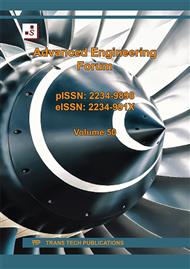[1]
G. Rousselier, Finite deformation constitutive relations including ductile fracture damage. Three dimensional constitutive relations and ductile fracture, Amsterdam North-Holland, (1981) 331-355.
DOI: 10.1016/b978-1-4832-8440-8.50105-8
Google Scholar
[2]
G. Rousselier, J. C. Devaux, G. Mottel, G. Devesa, Nonlinear fracture mechanics ASTM, Elastic Plastic Fracture, Vol. II (1983).
DOI: 10.1520/stp27716s
Google Scholar
[3]
G. Rousselier, Ductile fracture models and their potential in local approach of fracture, Nuclear Engineering and Design, 105 (1987) 97-111.
DOI: 10.1016/0029-5493(87)90234-2
Google Scholar
[4]
G. Rousselier, J. C. Devaux, G. Mottel, G. Devesa, A methodology of ductile fracture analysis based on damage mechanics: an illustration of a local approach of fracture, Nonlinear Fracture Mechanics: Volume II - Elastic Plastic Fracture, ASTM STP 995, Philadelphia, (1989) 332-354.
DOI: 10.1520/stp27716s
Google Scholar
[5]
M.K. Samal, On the application of Rousselier´s damage model to predict fracture resistance behavior of Zircaloy fuel pin specimens, Procedia Engineering 55 (2013) 710 – 715
DOI: 10.1016/j.proeng.2013.03.319
Google Scholar
[6]
S. Arun, Finite element modelling of fracture & damage in austenitic stainless steel in nuclear power plant, PhD. Thesis, Faculty of Engineering and Physical Sciences, University of Manchester (2015)
Google Scholar
[7]
A. Shterenlikht, 3D CAFE modelling of transitional ductile-brittle fracture in steels, PhD Thesis, Department of mechanical engineering, University of Sheffield (2003).
Google Scholar
[8]
S.J. Wu, C.L. Davis, A. Shterenlikht, I.C. Howard, Modeling the ductile-brittle transition behavior in thermomechanically controlled rolled steels, Metallurgical and Materials Transactions A., 36A (2005) 989-997.
DOI: 10.1007/s11661-005-0292-z
Google Scholar
[9]
A. Shterenlikht, I. C. Howard, The CAFE model of fracture - application to a TMCR steel, Fatigue Fract Engng Mater Struct, 29 (2006) 770-787.
DOI: 10.1111/j.1460-2695.2006.01031.x
Google Scholar
[10]
R. Cuamatzi-Melendez, 3D Cellular Automata Finite Element modelling of ductile and cleavage fracture PH Thesis, Department of Mechanical Engineering, University of Sheffield (2008).
Google Scholar
[11]
A. Shterenlikht, I. C. Howard, Cellular automata finite element (CAFE) modelling of transitional ductile-brittle fracture in steel, Proceedings of the 15th European Conference of Fracture (2015).
Google Scholar
[12]
A. Shterenlikht, L. Margetts, Three-dimensional cellular automata modelling of cleavage propagation across crystal boundaries in polycrystalline microstructures, The Royal Society Publishing A471 (2015).
DOI: 10.1098/rspa.2015.0039
Google Scholar
[13]
A. Shterenlikht, L. Margetts, L. Cebamanos, Modelling fracture in heterogeneous material on HPC system using a hybrid MPI/Fortran coarray multi-scale CAFE framework, Advances in Engineering Software Vol. 125 (2018) 155-166.
DOI: 10.1016/j.advengsoft.2018.05.008
Google Scholar
[14]
L. Yang, A. Shterenlikht, X. Renc, J. Hea, Z. Zhanga, CAFE based multi-scale modelling of ductile-to-brittle transition of steel with a temperature dependent effective surface energy, Materials Science & Engineering A, 755 (2019) 220–230.
DOI: 10.1016/j.msea.2019.04.012
Google Scholar
[15]
S. Hewitt, L. Margetts, A. Shterenlikht, A. Revell, A massively parallel multiscale CAFE framework for the modelling of fracture in heterogeneous materials under dynamic loading, Advances in Engineering Software Vol. 139 (2020) 102737.
DOI: 10.1016/j.advengsoft.2019.102737
Google Scholar
[16]
L. Yang, P. Sakari, R. Xiaobo, H. Jianying, K. Jukka, Z. Zhang, A multi-barrier model assisted CAFE method for predicting ductile-to-brittle transition with application to a low-carbon ultrahigh-strength steel, Mechanics of Materials, 152 (2021) 103669.
DOI: 10.1016/j.mechmat.2020.103669
Google Scholar
[17]
K. Teferra, D. J. Rowenhorst, Optimizing the cellular automata finite element model for additive manufacturing to simulate large microstructures, Acta Materialia (2021) 1-35.
DOI: 10.1016/j.actamat.2021.116930
Google Scholar
[18]
A. Balasubramanian, L. Margetts, V. D. Vijayanand, M. Mostafavi, Statistical modeling of fracture using cellular automata finite element, Theoretical and Applied Fracture Mechanics Vol. 115 (2021) 103066.
DOI: 10.1016/j.tafmec.2021.103066
Google Scholar
[19]
L. C. Pereira, J. C. Garcia de Blas, S. Griza, F. A. Ibrahim, Use of instrumented Charpy testing on the fracture toughness characterization of metallic materials, Tecnol Metal Mater Min 18 (2021).
DOI: 10.4322/2176-1523.20212469
Google Scholar
[20]
F. Vodopivec, B. Arzensek, D. Kmetic, J. Vojvodic-Tuma, In the Charpy fracturing process, Materiali in Tehnologije, 37 (2003) 317-326.
Google Scholar
[21]
EN ISO 14556:200 British Standard, Method for precision determination of Charpy V-notched impact energy for metals, BS131-6 (1987).
Google Scholar
[22]
J. Faleskog, C.F. Shih, Micromechanics of coalescence - I. Synergetic effects of elasticity, plastic yielding and multi-size-scale voids, Journal of the Mechanics and Physics of Solids, 45 (1997) 21-50.
DOI: 10.1016/s0022-5096(96)00078-6
Google Scholar
[23]
A.G. Franklin, Comparison between a quantitave microscopic and chemical methods for assessment of nonmetallic inclusions, J. Iron and Steel Institute, 207 (1969) 181-186.
Google Scholar
[24]
R. Batisse, G. Bethmont, G. Devesa, G. Rousselier, Ductile fracture of a 508 Cl 3 steel in relation with inclusion content: The benefit of the local approach of fracture and continuum damage mechanics, Nuclear Engineering and Design, 105 (1987) 113-120.
DOI: 10.1016/0029-5493(87)90235-4
Google Scholar
[25]
J. Von Newmann, Theory of self-reproducing automata, University of Illinois Press (1966).
Google Scholar
[26]
Palisade, @RISK, The decision tools suite, URL: https://www.palisade.com/ (2007).
Google Scholar
[27]
G. Bernaur, W. Brocks, Micro-mechanical modelling of ductile damage and tearing - results of European numerical round robin, Fatigue Fract Engng Mater Struct, 25 (2001) 363-384.
DOI: 10.1046/j.1460-2695.2002.00468.x
Google Scholar
[28]
Z. H. Li, B. Bilby, I. C. Howard, A study of the internal parameters of ductile damage theory, Fatigue Fract Engng Mater Struct, 17 (1994) 1075-1087.
DOI: 10.1111/j.1460-2695.1994.tb00836.x
Google Scholar


